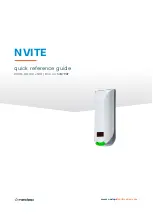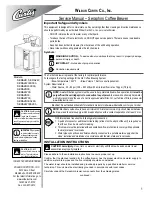
27
The Manufacturer disclaims any and whatever liability for damages to persons, animals or property arising from non compliance
with the instructions given herewith and/or from an improper use of the lift or any use other than specified in this manual.
To lift the vehicle, proceed as follows:
• Check that the arms are turned towards the outside of the lift in a way that will not hamper the vehicle access between the columns.
• Place the vehicle between the lift columns.
• Turn the arms and pull out the extensions bringing the pads to the points designed for lifting the vehicle as indicated by the vehicle manufacturer.
• Check that the Emergency Switch/Disconnector (17, Fig. 1) is set to 1 (ON) and turn it if necessary.
• Press the UP push-button (19, Fig. 1) and lift the vehicle by 10 cm.
• Check the correct insertion of the rubber pads.
• Check vehicle stability.
• Press the UP push-button (19, Fig. 1) and lift the vehicle.
• Turn the Emergency Switch/Disconnector (17, Fig. 1) to 0 (OFF) before accessing the working area.
5.3 LOWERING PROCEDURE
To lower vehicle, proceed as follows:
• Check that the Emergency Switch/Disconnector (17, Fig. 1) is set to 1 (ON) and turn it if necessary.
• Press the DOWN push-button (18, Fig. 1) until both carriages reach the minimum height.
• Turn Emergency Switch/Disconnector (17, Fig. 1) to 0 (OFF).
• Turn the arms towards the outside of the lift in a way that will not hinder vehicle exit.
• Move the vehicle out of the lifting area.
5.4 SAFETY DEVICES
WARNING: The following safety devices shall by no means be tampered with or disabled; they shall also be always kept in top
working conditions:
• "Dead-man" control panel: all the lift functions require the presence of an operator.
• Emergency Switch/Disconnector (17, Fig. 1): if turned to 0 (OFF), it stops lift operation.
• The foot protection guards fitted to the arms (10-13, Fig. 1) prevent the risk of crushing of the operator's feet during the final stage of arm descent.
• Side guards (4, Fig. 12) on the columns prevent the squashing of operator's feet during the arm lowering final stage.
• Arm anti-rotation mechanical safety locks with automatic engagement (7, Fig. 14): prevent the rotation of the lifting arms when the carriage is lifted.
• Back-up split nut on each carriage: supports load in the event of main split nut failure.
• Minimum height limit switch (6, Fig. 13) and maximum height limit switch (7, Fig.13): they stop the motor to ensure that carriages will not run over the
permitted stroke.
• Safety device controlling carriage misalignment: this device uses a microswitch (Fig.15) to prevent accidental carriage misalignment.
• Low-voltage additional electric circuit: this circuit is electric shockproof.
• Permanent arm immobilising device (fig 6A).
5.5 EMERGENCY LOWERING
:
WARNING:
The following operations shall be carried out only:
•
When lift does not go down due to a power failure or in case of power cut-off.
•
In case of absolute need.
•
By a single qualified operator.
•
If the lift area is delimited and made accessible to a single operator.
Lower the vehicle to ground manually by turning the lifting screws with a suitable wrench and following this procedure:
1) Disconnect the lift from the electric power network.
2) Check that no people, animals or things are in the hazardous area (squashing hazard).
2) Remove the pulley cover.
3) Apply a suitable wrench to the lifting screw and turn counter clockwise until lowering the vehicle to ground.
Содержание ERCO 3222N CEL
Страница 2: ......
Страница 8: ...8 1 2 DIMENSIONI INGOMBRO 2585 85 130 6 0 0 9 4 0 1250 850 1870 1915 2570 3230 2480...
Страница 11: ...11 1 5 SCHEMA APPLICAZIONE PITTOGRAMMI Fig 6 BLOCCAGGIO PERMANENTE BRACCI Fig 6A 4 9 P1 8 3 6 1 2 P2 5 7 9...
Страница 12: ...12 POSIZIONE OPERATORE 1 6 ZONE A RISCHIO Fig 7 700 700 5000...
Страница 16: ...16 Fig 16 5 6 7 2 4 3...
Страница 31: ...31 9 0 SCHEMA ELETTRICO...
Страница 32: ...32...
Страница 33: ...33 FU1 FU3 KM1 KM2 KM3 KM4 FU2 TC1 CB2C NT...
Страница 36: ......
Страница 42: ...8 1 2 OVERALL DIMENSIONS 2585 85 130 6 0 0 9 4 0 1250 850 1870 1915 2570 3230 2480...
Страница 45: ...11 4 9 P1 8 3 6 1 2 P2 5 7 9 1 5 PICTOGRAMS APPLICATION DIAGRAM Fig 6 PERMANENTLY IMMOBILISING THE ARMS Fig 6A...
Страница 46: ...12 700 700 5000 POSITION OPERATOR 1 6 HAZARDOUS AREAS Fig 7...
Страница 50: ...16 Fig 16 5 6 7 2 4 3...
Страница 65: ...31 9 0 ELECTRONIC CIRCUIT BOARD DIAGRAM...
Страница 66: ...32...
Страница 67: ...33 FU1 FU3 KM1 KM2 KM3 KM4 FU2 TC1 CB2C NT...
Страница 70: ......
Страница 76: ...8 1 2 DIMENSIONS D ENCOMBREMENT 2585 85 130 6 0 0 9 4 0 1250 850 1870 1915 2570 3230 2480...
Страница 79: ...11 4 9 P1 8 3 6 1 2 P2 5 7 9 1 5 EMPLACEMENT DES PICTOGRAMMES Fig 6 BLOCAGE PERMANENT DES BRAS Fig 6A...
Страница 80: ...12 700 700 5000 POSITION OPERATEUR 1 6 ZONES A RISQUE Fig 7...
Страница 84: ...16 Fig 16 5 6 7 2 4 3...
Страница 99: ...31 9 1 SCHEMA CARTE ELECTRONIQUE...
Страница 100: ...32...
Страница 101: ...33 FU1 FU3 KM1 KM2 KM3 KM4 FU2 TC1 CB2C NT...
Страница 104: ......
Страница 110: ...8 1 2 ABMESSUNGEN 2585 85 130 6 0 0 9 4 0 1250 850 1870 1915 2570 3230 2480...
Страница 113: ...11 4 9 P1 8 3 6 1 2 P2 5 7 9 1 5 APPLIKATIONSSCHEMA F R PIKTOGRAMME Abb 6 DAUERHAFTE SPERRE DER ARME Abb 6A...
Страница 114: ...12 700 700 5000 POSITION BEDIENER 1 6 GEFAHRENBEREICHE Abb 7...
Страница 118: ...16 Abb 16 5 6 7 2 4 3...
Страница 133: ...31 9 1 SCHEMA DER PLATINE...
Страница 134: ...32...
Страница 135: ...33 FU1 FU3 KM1 KM2 KM3 KM4 FU2 TC1 CB2C NT...
Страница 138: ......
Страница 144: ...8 1 2 DIMENSIONES TOTALES 2585 85 130 6 0 0 9 4 0 1250 850 1870 1915 2570 3230 2480...
Страница 147: ...11 4 9 P1 8 3 6 1 2 P2 5 7 9 1 5 ESQUEMA DE APLICACI N DE LOS PICTOGRAMAS Fig 6 BLOQUEO PERMANENTE BRAZOS Fig 6A...
Страница 148: ...12 700 700 5000 POSICI N OPERADOR 1 6 ZONAS EN RIESGO Fig 7...
Страница 152: ...16 5 6 7 2 4 3 Fig 16...
Страница 167: ...31 9 1 ESQUEMA TARJETA ELECTR NICA...
Страница 168: ...32...
Страница 169: ...33 FU1 FU3 KM1 KM2 KM3 KM4 FU2 TC1 CB2C NT...
Страница 172: ......
Страница 173: ......
















































